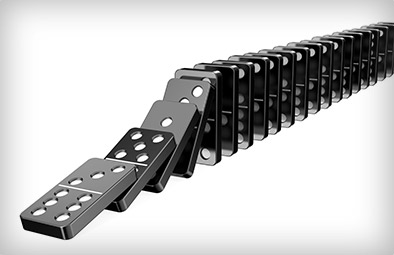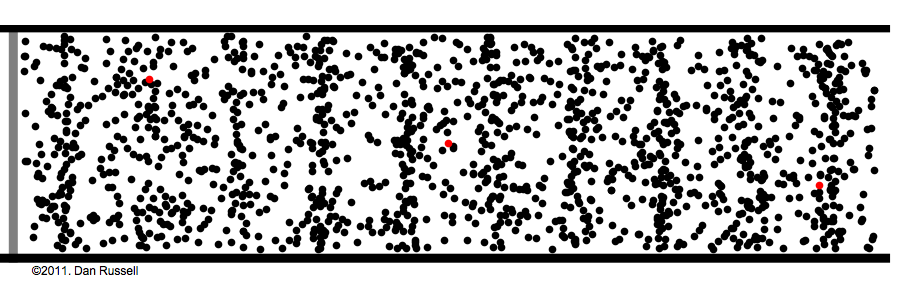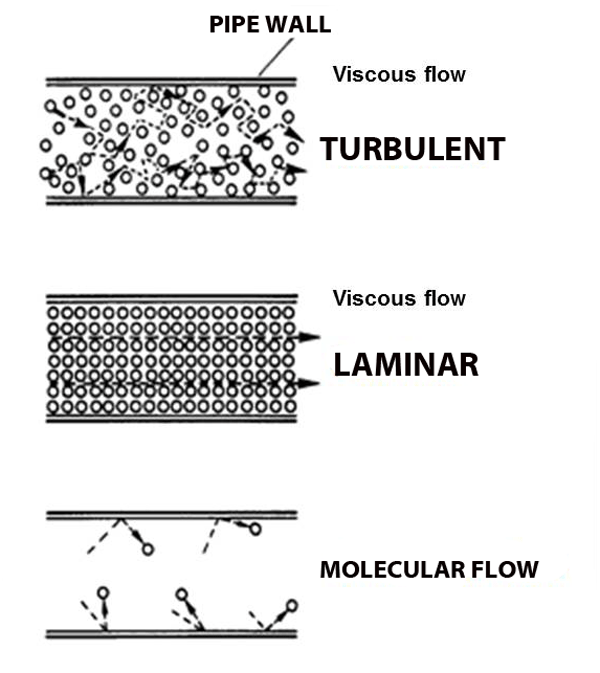...
as pressure drops, mean free path increases, because there are less molecules to run into. Gasses can act very differently depending on the the length of the mean free path. But let's start with what we're used to: the air around us.
Behaviors of gasses
The air around us
...
as dominos: Viscous Flow
Remember: molecules are tiny, and there's a lot of them in the air around you—there are more molecules within a literal hair's width of a pinhead than one could possibly count. And what are they doing? Bouncing into each other. Knock enough molecules in one direction and those molecules will knock into the next like dominoes, and that's pretty much how sound happens:
Sound Sound is waves of rapid pressure change, and no molecules need to travel from the speaker to the ear to hear. Watch the red dots in the above animation, see how they just oscillate back and forth? Now compare that to the smoke going back and forth with the sound waves, same thing:
The
...
speakers moved
...
enough air to extinguish the flames, but it wasn't the air from the speaker that put out the candles. The air from the speaker started the domino chain, but it was the air already next to the flame that put the flame
...
out.
And the domino chain that is the sound wave moves through the air so fast that it looks like all the flames went out at once, but the flames get extinguished one after the next, at the speed of sound, but the speed of sound is simply too fast to see. So the sound has direction, but the air doesn't flow. This lack of airflow is unlike blowing out a flame, where the air itself moves in a particular direction.
Blow out a flame and
...
...
the continuous stream from behind
...
makes the air flow from one place to another—it's like pushing a crowd from the back. Keep pushing and it keeps flowing, as long as it has somewhere to go.
...
we call this behavior viscous flow.
Suction pumps , and it's what we're used to. Pumps create flow in just the opposite way with suction: remove some molecules and the ones next to it fall into the empty space left behind and, and just like the dominoes, that next door molecule leaves behind it's own void behind, which that gets filled by other molecules, and so on and so forth.
Viscous flow depends on there being enough molecules around for domino chains to happen.what happens when the pressure gets so low that molecules hardly run into each other? Molecular flow.
Flowing through a pipe
Viscous flow: like a river
Under normal atmospheric conditions– gas molecules are constantly running into each other (short mean free path) and bouncing off.
In fact, when you blow out a candle it's not the molecules from your lungs that put out the flame, there are too many air molecules in the way; your lung-air molecules merely knock forward the air molecules in front of your mouth, which knock forward the air molecules above the cake, which in turn knock the air molecules in the flame away from the wick, taking their heat with them, and extinguishing the flame.
Though if you keep blowing those lung air-molecules will
And pumps create suction in just the opposite way: remove some molecules and the ones next to it fall into the void, leaving their own void behind them, which gets filled by other molecules, and so on and so forth. This domino-chain like behavior is called viscous flow, and it's what we're used to.
...
Both blowing and sucking create the domino-chain-like behavior known as viscous flow, and it's what we're used and expect because we live out our entire lives in this gas we call 'air', always at atmospheric pressure. When viscous flow is slow it can be smooth (laminar) like the smoke from the flame, and when the flow gets fast it gets rough (turbulent), like the blown smoke. But what happens when the pressure gets so low that molecules hardly run into each other? No more domino chains, no more viscous flow. Molecular Flow.
Molecular flow: air hockey analogy
Imagine the world's largest air hockey table, you place a few pucks on the table, and hit them in random directions. They'll hit each other sometimes, but they're much more likely to hit the wall. And it's just as likely to bounce back into your own goal as it is to bounce into the opponent's goal. Now replace the flat of the table with the space inside a vacuum chamber, and replace the pucks with molecules; this is molecular flow: when a molecule is more likely to hit a chamber wall than it is to hit another molecule, and there is no general directionality to the flow (see figure above the air hockey table), unlike viscous flow.
...







